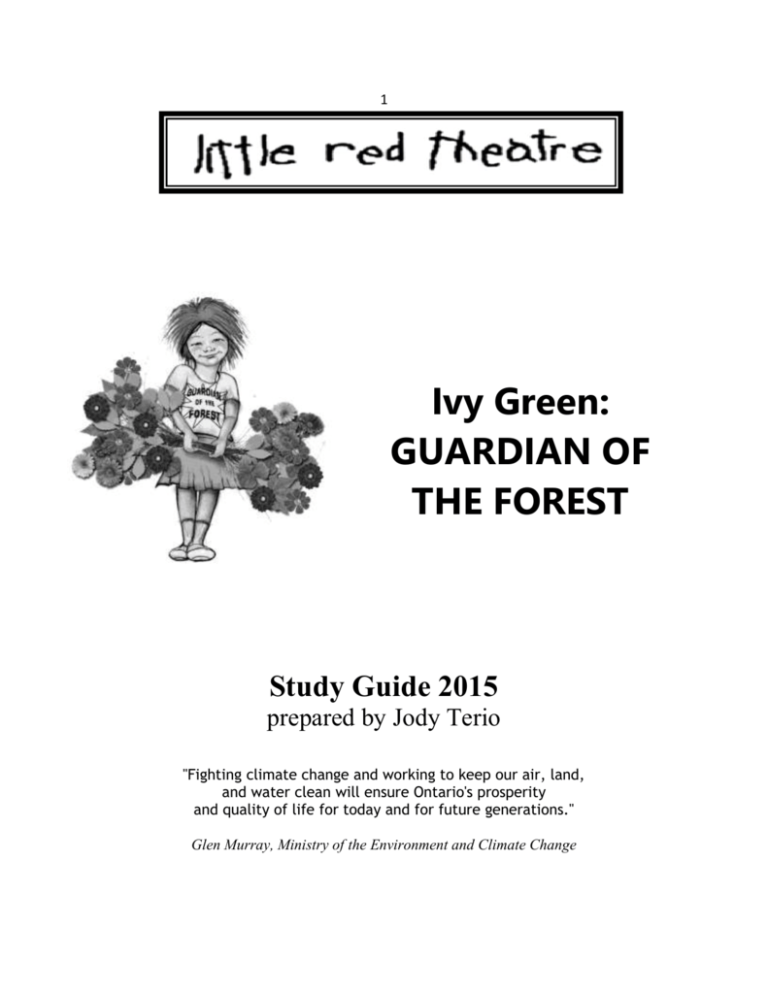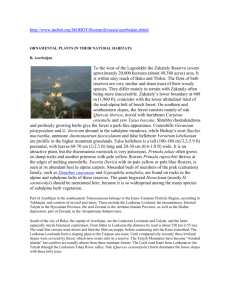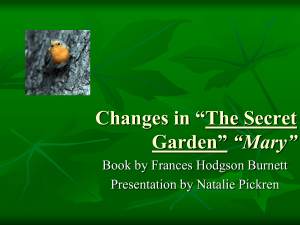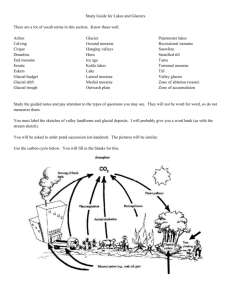Ivy Green: GUARDIAN OF THE FOREST Study Guide 2015
advertisement

1 Ivy Green: GUARDIAN OF THE FOREST Study Guide 2015 prepared by Jody Terio "Fighting climate change and working to keep our air, land, and water clean will ensure Ontario's prosperity and quality of life for today and for future generations." Glen Murray, Ministry of the Environment and Climate Change 2 March 1 2015 Dear Teachers: Thank you for inviting us to your school for a performance of Ivy Green:Guardian of the Forest. April is Earth month when we honour our relationship with the planet herself. And in celebration of this abundant time of spring and awakening we introduce Ivy Green, a special child who talks to flowers and animals. You will also meet other lovers of plants and nature, Judith, the herbalist and Lawrence, Ivy's friend and through them, we understand the special language of plants and animals. I invented Ivy this past summer during a herb walk at the Women’s Herbal Conference in Maine US where I attended outdoor workshops with 700 other women, on a variety of issues relating to plants. It was clear at the time that I was amongst many who communicated with plants in their own special ways and could offer a rich variety of knowledge each pertaining to her own specialty. Having always been an avid gardener and following climate change and deforestation issues for a long time, I wanted to write a play for younger students. It is simple and more about loving forests than if I was writing for an older group who might be on the front lines of environmental groups in a few years. But I do demonstrate in this play that when a forest is being threatened however small and worldly insignificant it might be, there are ways that we can be pro- active in keeping the forest protected for future generations. Bringing awareness to their need to be guardians is going to benefit them in the long term. This is also a play about magic, music and expressing love and that is what Ivy teaches. We use a positive childlike approach to what our green spaces are doing for us and what they offer us in food and joy and beauty. This play is most suitable for K - 4. We have created a special website for Ivy that is kid friendly and are hoping that the website will active by the time you see the show. I will pass out information about the website at your performance and hopefully after the presentation some of your students will be interested in visiting Ivy there. Jody TerioArtistic Director email: littleredtheatre@yahoo.ca 3 To watch a child completely engaged in an arts experience is to recognize that the brain is on, driven by the aesthetic and emotional imperative to make meaning, to say something, to represent what matters. ...from "The Arts Go to School", David Booth and Masayuki Hachiya little red theatre provides a diverse selection of shows on different topics and we think this is critical in terms of meeting curriculum needs. Taking part in this presentation meets your Arts component, which includes Visual Art and Music as well as Drama. Having theatre at your school greatly enhances student awareness and is necessary for school CURRICULUM expectations. And this presentation also fulfills your Science and Heritage component. Through study of the arts, students learn about some of the diverse artistic practices, both traditional and contemporary, of a variety of cultures. They learn that they are part of a living and changing culture. They also learn to appreciate the similarities and differences among the various forms of artistic expression. Science and Technology THE NATURE OF SCIENCE AND TECHNOLOGY The primary goal of science is to understand the natural and human-designed worlds and refers to certain processes used by us for obtaining knowledge about nature. Science is a dynamic and creative activity with a long and interesting history of which many societies have contributed their knowledge and understanding. Scientists continuously assess and judge the soundness of scientific knowledge claims by testing laws and theories, and modifying them in light of compelling new evidence or a reconceptualization of existing evidence. Environmental education is defined as: Education about the environment, for the environment, and in the environment that promotes an understanding of, rich and active experience in, and an appreciation for the dynamic interactions of: 4 The Earth’s physical and biological systems The dependency of our social and economic systems on these natural systems The scientific and human dimensions of environmental issues The positive and negative consequences, both intended and unintended, of the interactions between human created and natural systems LET'S MEET IVY’S FOREST FRIENDS!! HUMMINGBIRDS Though they are some of the smallest birds in the world, hummingbirds have big personalities. These flying jewels captivate our hearts and our binoculars. We know about hummingbirds because of the humming sound created by their beating wings which flap at high frequencies audible to humans. There are between 325 and340 species of hummingbirds. This family has the second greatest number of species of any bird family on Earth. Many plants pollinated by hummingbirds produce flowers in shades of red, orange and bright pink although the birds will take nectar from flowers of many colours. All hummingbirds depend on flower nectar to fuel their high metabolisms and hovering flight. With the exception of insects, hummingbirds while in flight have the highest metabolism of all animals, a necessity in order to support the rapid beating of their wings during hovering and fast forward flight. During flight, oxygen consumption per gram of muscle tissue in a hummingbird is approximately 10 times higher than that seen for elite human athletes. Hummingbirds consume more than their own weight in nectar each day and to do so they must visit hundreds of flowers daily. They are continuously hours away from starving to death and 5 can store just enough energy to survive overnight. They are capable of slowing their metabolism at night or when food is not readily available, entering a hibernation like sleep state known as torpor and the body temperature falls from 40 degrees to 18 degrees celsius. Ontario enjoys many visits by the Ruby-throated Hummingbird(Archilochus colubris) Description: The adult male is easy to identify in good light with his spectacular ruby red gorget (throat) and emerald green back. His tail is entirely green and has a deep V-shaped notch. The male is smaller than the female with a shorter bill. The adult female has an emerald green back with a white throat and breast. Her tail is shorter than the male and more rounded with white tips. Immature males and females are almost identical to the adult female and very difficult to tell apart except when the young male is starting to grow gorget feathers. SOLOMON’S SEAL Solomon’s Seal (polygonatum biflorum) is an elegant plant native to North America. The slender, arching stems have alternating lance-shaped leaves that are either green or tipped with white. The small, tubular white flowers dangle underneath the leaves. More mature plants tend to have more flowers and are a bit more showy. Solomon's Seal is a medicinal herb that has diverse healing properties. It can be used as a herbal tincture (best use), salve, tea or supplement. As an alternative medicine, it gives relief, healing or mending to sports injuries and other acute injuries related to tendons, joints, ligaments, bones, bruises, connecting tissues, cartilage, osteoarthritis, etc. It also soothes and repairs gastrointestinal inflammation and injuries. It is effective for feminine issues, such as menstrual cramps, PMS, bleeding, and the like. Additionally, it is known to lower blood pressure, relieve dry coughs, and to increase concentration and mental clarity. Solomon's Seal has a rich history that goes back many hundreds of years. Herbalists and healers, both in Europe and North America and the Far East, for centuries have written about its diverse effects on numerous conditions. On one hand, it seems to be a "miracle plant," and numerous practitioners consider a bottle of tincture or a jar of salve to be an absolute must in one's medicine cabinet or emergency kit. BIRCH TREE by Anna Fernandez This site brought to you by The School of Natural Healing & Christopher Publications Few trees have been so important to so many people. Historically, Birch (Betula papyrifera) was the most important tree to many indigenous people across the northern latitudes around the 6 world, increasing the quality of life of people for thousands of years. The fact that the Birch tree varies in thickness and can be split in numerous layers and has a resinous inner bark which makes it waterproof and resistant to decay, makes it an extremely versatile tree. One of its great uses was for shelter. Indigenous people of United States and Canada used Birch to make Wigwams, Tee-pees and other structures for living. Probably the most well know use of Birch is its use in making Canoes. Canoes have been a part of cultures around the world for many hundreds of years. The Anishinabeg (natives of what is now Michigan) had their own version of the Birch Bark Canoe. It was important to peel the bark in “one continuous sheet, usually in late spring or early summer when the actively dividing cambium causes the bark to loosen.” The selection and peeling of trees often was a family affair accompanied by a religious ceremony during which the spirits of the forest were offered thanks and asked to provide protection and strength.” The Anishinabeg would then roll up the peeled bark inside out. The inner side is the waterproof side that was in contact with the water when canoeing. Because of its horizontal grain, the bark would not split lengthwise and could be sewn together. Peeled bark was a valuable commodity and was often traded for other goods. LAVENDER Lavender is an herb native to northern Africa and the mountainous regions of the Mediterranean. The herb is highly regarded for skin and beauty and is commonly used in fragrances and shampoos to help wash and purify the skin. In fact, the word lavender originally stems from the Latin word ‘lavare’ which means "to wash". Lavandula (common name lavender) is a genus of 39 known species of flowering plants in the mint family, Lamiaceae. It is native to the Old World and is found from Cape Verde and the Canary Islands, southern Europe across to northern and eastern Africa, the Mediterranean, southwest Asia to southeast India. Many members of the genus are cultivated extensively in temperate climates as ornamental plants for garden and landscape use, for use as culinary herbs, and also commercially for the extraction of essential oils. The most widely cultivated species, Lavandula angustifolia is often referred to as lavender, and there is a colour named for the shade of the flowers of this species. 7 ECHINACEA ... is a genus, or group of herbaceous flowering plants in the daisy family, Asteraceae. The echinacea genus has nine species, which are commonly called coneflowers. They grow easily in eastern and central North America, where they are found growing in moist to dry prairies and open wooded areas as well as in regular gardens. . They have large, showy heads of composite flowers, blooming from early to late summer. The generic name is derived from the Greek word ‘echino’, meaning "sea urchin," due to the spiny central disk. These flowering plants and their parts have different purposes. Some species are cultivated in gardens for their showy flowers, and some are traditionally used to treat and prevent common cold, flu, and other infections. JEWELWEED: Impatiens capensis The Jewelweed plant has been used for centuries in North America by Native Americans and Herbalists, as a natural preventative and treatment for poison ivy and poison oak; and is a folk remedy for many other skin disorders. Jewelweed is best known for its skin healing properties. The leaves and the juice from the stem of Jewelweed are used by herbalists as a treatment for poison ivy, oak and other plant induced rashes, as well as many other types of dermatitis. Jewelweed works by counter-reacting with the chemicals in other plants that cause irritation. Poultices and salves from Jewelweed are a folk remedy for bruises, burns, cuts, eczema, insect bites, sores, sprains, warts, and ringworm. A great website for you and your students to visit!! PROTECTTHEFORESTS.ORG; A LITTLE ABOUT THE WORK OF GREENPEACE! We campaign for forest protection because, without healthy, thriving forests, planet Earth cannot sustain life. As much as eighty per cent of the world's forests have been degraded or destroyed. Greenpeace is campaigning for zero deforestation by 2020 to protect what is left of these extraordinary ecosystems. 8 But the importance of forests stretches far beyond their own boundaries. Forests help to regulate the Earth's climate because they store nearly 300 billion tonnes of carbon in their living parts roughly 40 times the annual greenhouse gas emissions from fossil fuels. When they're destroyed through logging or burning, this carbon is released into the atmosphere as the climate changing greenhouse gas, carbon dioxide. The destruction of forests is responsible for up to a fifth of the world's greenhouse gas emissions - more than every plane, car, truck, ship and train on the planet combined. Forests also regulate water flow and rainfall so we depend on them to grow our crops and food. The loss of forest in one part of the world can have severe impacts in another; forest loss in Amazonia and Central Africa can severely reduce rainfall in the USA Midwest, for example. With so many of the world's forests already destroyed, we urgently need to protect what is left. Yet industry is still relentlessly converting forests into disposable products that end up in our shopping baskets - while pushing species to the brink of extinction, destroying the lives and livelihoods of forest communities and exacerbating global climate change. Greenpeace is campaigning for zero deforestation, globally, by 2020.To achieve this, we challenge destructive industries to change their practices, and we inspire consumer action to demand that our food, paper and timber products aren't linked to forest destruction. We lobby political power holders to take the co-ordinated international and local political action that's needed to protect the world's forests, the rights of the people who depend on them, biodiversity and the climate. We work alongside indigenous communities at the frontline of forest destruction - in the Amazon, the Congo, Indonesia - to investigate, document, expose and take action against forest destruction. With the help of hundreds of thousands of supporters, we've won some amazing victories. Deforestation of the Amazon for soya and beef has significantly reduced due to the soya and cattle moratoria, the Great Bear Rainforest in Canada has been protected and is being sustainably managed, 80,000 hectares of northern Finnish reindeer grazing forests have been protected, and, thanks to pressure from our supporters, multinational giants like Nestlé and Unilever have changed their palm oil sourcing policies to help protect Indonesia's rainforests and peatlands. In recent years, the possibility of a global political framework to reduce emissions from deforestation and degradation (REDD) has moved firmly onto the international political agenda. Greenpeace is campaigning for the right deal - which, if achieved, could benefit biodiversity, people and the climate as well protecting the world's forests. 9 THE OAK RIDGES MORAINE The Oak Ridges Moraine is an ecologically important geological landform in the Mixedwood Plains of south-central Ontario, Canada. The moraine covers a geographic area of 1,900 square kilometres (730 sq mi) between Caledon and Rice Lake, near Peterborough. One of the most significant landforms in southern Ontario, the moraine gets its name from the rolling hills and river valleys extending 160 km (99 mi) from the Niagara Escarpment east to Rice Lake. It was formed 12,000 years ago by advancing and retreating glaciers (see geological origins, below). The moraine is currently a contested site in Ontario, since it stands in the path of major urban development. The Oak Ridges Moraine is a pair of large ridges composed of four elevated wedges. It is bounded to the west by the Niagara Escarpment, a cuesta which was critical to the formation of the moraine, and to the east by the Trent River and Rice Lake. The four wedges (Albion, Uxbridge, Pontypool and Rice Lake from west to east) formed in stages, though some synchronous formation also occurred at an early period of formation. The moraine peaks at the Uxbridge wedge, generally rising from east to west, a result of the moraine's west-to-east formation. That is, the western portion of the moraine received earlier and more frequent sedimentary deposition than the eastern portion, as the ice lobes which controlled the moraine's eastern formation slowly retreated. The Rice Lake wedge is separated from the other wedges where the Oak Ridges Moraine intersects Rice Lake. Simple Steps to a Sustainable Garden Gardens are important wildlife sites. A little effort can ensure your garden stays beautiful without harming the planet. Many of us think of our gardens as our refuges from the world but our attempts at turning our own little patch into an idyll can have far reaching and detrimental consequences. Below are ways you can make a real difference. Respect Nature Encourage wildlife in your garden *put up nest boxes, build a pond *plant a wide range of native flowers and plants. Save Energy & Water *Avoid using a hose where possible, use a watering can or buckets of water. *Invest in a rain barrel to collect rainwater to use in the garden. *Try to water plants in the morning or evening instead of in the heat of the day This will enable the water to soak through to the roots, rather than simply evaporate. *Let your grass grow a little longer, it will require less water. 10 Reduce, Reuse, Recycle *use organic and environmentally friendly fertilisers and pesticides - organic gardening reduces pollution and is better for wildlife. Chemicals will eventually end up in the sea and can upset the delicate balance of lifecycles. *Reuse plant pots and other items to make unusual features in your garden. *Start a compost heap or wormery - these recycle organic waste, including food, and produce excellent compost. Purchasing *Respect nature – try to use dark based compost, not peat that is irreplaceable. If you are unable to use your own compost, alternatives are available in most garden centres and DIY stores. *Only buy garden bulbs from cultivated stocks. *Grow your own food – This is the best way to ensure you know what you’re eating, and it cuts down on wasteful packaging and transportation. *Use natural materials (paints, wood, upholstery) where possible and avoid concrete which is not eco friendly Health *Spending time in the garden is an excellent way to get exercise and fresh air *Remember to spend time relaxing in your garden, put your feet up and enjoy the benefits of your hard work TIP: Encouraging wild life to live and feed in your garden is great natural pest control and is increasingly important as natural habitats are lost in the wild. More great gardening info on the following website: http://www.bbc.co.uk/gardening/basics/techniques/organic_wildgardens1.shtml STUDENTS CAN TRY THIS QUIZ ON THE COMPUTER IN YOUR CLASSROOM!! http://www.greengrin.co.uk/ This quiz asks you a few little questions about your life and your feelings to help us work out how you score on our Green Grin-o-meter. Your score will be made up of three parts: Happiness, Health and your Ecological Footprint. Each of your scores will be given out of a total of 5. For health and happiness, 5 is the best score and a score of 1 tells us that there’s room to make some changes! 11 Your ecological footprint tells us your impact on the environment, by causing pollution and using resources. So the lower your ecological footprint is, the better and the less damage you cause for the environment. Another great site for you and your students to visit! http://www.recyclezone.org.uk/ Suggested Reading For Teachers: ‘This Changes Everything’ by Naomi Klein A long and thorough look at the history of the issue of climate change and its connections with capitalism. It isn’t depressing!! And did I say ‘thorough’!! You will not be left confused or in doubt. 'The Language of Flowers' by Vanessa Diffenbaugh This book brings a heightened awareness of the subtleties around the origins of flowers in the Victorian England sense, their hidden meanings for example, how thoughts are provoked by different colored roses and why sunflowers make bad wedding flowers. It is a primer in the language of love. 'Ecoholic' by Adria Vasil, slightly dated as it is written in 2007 but many of the details still apply. Lots of tips for greening your life. 'Sleeping Naked is Green' by Vanessa Farquharson This is a charming and funny account for a person committed to going green. Vanessa takes the 365 day challenge to make one change in her life every day to make it more green. 12 WORKSHEET FOR STUDENTS NAME: _______________________ GRADE:_______________ IVY GREEN: GUARDIAN OF THE FOREST 1. What are some of the messages in this story? ______________________________________________________________ ______________________________________________________________ ___________________________________________________________ 2. Why do you think that Ivy could understand the language of flowers and animals? ______________________________________________________________ ____________________________________________________________ 3. Do you understand the language of flowers and animals? _____________________________________________________________ 4. If yes, which ones? _____________________________________________________________ 5. What was your favourite part of the play and why? ______________________________________________________________ ______________________________________________________________ ___________________________________________________________ 6. Draw a picture of your favourite scene in the play in the box below. 7. If you could write your own play, what would it be about? _____________________________________________________________ ______________________________________________________________ ______________________________________________________________________ 13 anansi anansi anansi anansi anansi "It is better to believe thananansi to disbelieve,anansi in so doing you bring everything to the realm of possibility." Albert Einstein We love to see your students’ impressions!! Send in your pictures and worksheets to: little red theatre 25 beaty avenue toronto m6k 3b3 Audio CDs of many of little red theatre’s plays are available on the little red theatre website: www.littleredtheatre.on.ca 4 Titles are available at the present time: THE SNOW QUEEN THE NAME OF THE TREE THE NIGHTINGALE THE UGLY DUCKLING GOLDILOCKS AND THE THREE CANADIAN BEARS ABOUT LITTLE RED THEATRE: Little red theatre was established in 1988 with the mandate of bringing professional level theatre productions to young people. The company was founded by Jody Terio, who has remained as Artistic Director since the organization’s inception. Little Red Theatre produces mixed and sometimes multi-media performances of puppetry, music, dance and theatre, and tours theatre productions throughout Ontario. Productions are aimed at a Kindergarten through Grade 6 and are presented at schools, libraries and special venues. Each year, Little Red Theatre strives to create original work inspired by great fairy tales and stories, and issues that children struggle with. Little Red Theatre performances are full theatre productions with an emphasis on high quality costumes, sets, visuals and great sound. We have 32 shows in our repertoire!! Since 1992, Little Red Theatre has been a non-profit registered charity and has financed its productions through performance fees and charitable donations. The lion’s share of revenues are earned, but additional funds are required to upgrade productions, increase artistic fees, and improve marketing efforts.







